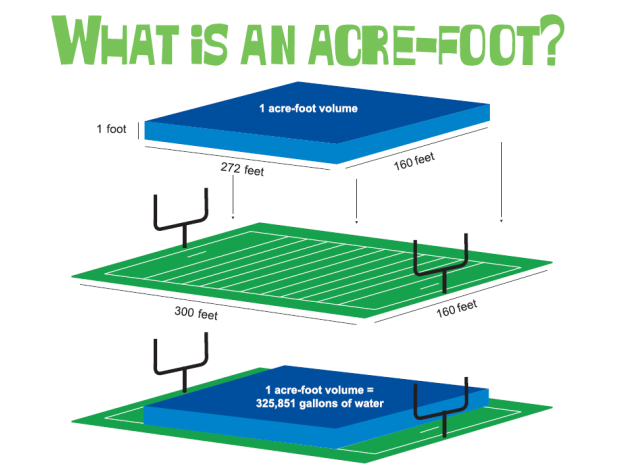Have you ever wondered how much water is in an acre foot? It’s a unit of measurement commonly used in agriculture, water resource management, and even in discussions about drought and water conservation. While it might sound like a strange unit, understanding it is crucial for comprehending how much water we have available and how we use it.

Image: inamre.blogspot.com
Imagine living on a farm and needing to irrigate your crops. You might be told that you have access to a certain number of acre-feet of water. But how much water is that, really? How many gallons would you need to fill up a pool to match that volume? The answer is far more than you might expect, and that is what we’ll explore in this article.
Understanding the Acre Foot
An acre foot is a unit of volume, not a unit of area. It represents the amount of water needed to cover one acre of land to a depth of one foot. Imagine a plot of land one acre in size. If you were to fill that plot with water to a height of one foot, that would be one acre foot of water.
To provide a more relatable representation, think of an Olympic-sized swimming pool. It holds approximately 660,000 gallons of water. An acre foot of water holds roughly 325,851 gallons. That means about half of an Olympic-sized swimming pool is equivalent to one acre foot.
Calculating Gallons in an Acre Foot
To understand how this volume is calculated, we need to consider the units involved. An acre is a unit of area, equal to 43,560 square feet. A foot is a unit of length. When we multiply these two units, we get a volume of 43,560 cubic feet.
Now, we need to convert cubic feet to gallons. There are 7.48 gallons in one cubic foot. Therefore, one acre foot (43,560 cubic feet) equals 325,851 gallons (43,560 cubic feet * 7.48 gallons/cubic foot).
Importance of Acre Foot Measurement
The acre foot is a vital unit of measurement in various areas, particularly water resource management. It is widely used to:
- Monitor water availability in reservoirs, rivers, and aquifers.
- Estimate irrigation needs and manage water allocations for agricultural purposes.
- Assess the impact of drought on water supply and develop conservation strategies.
- Plan for future water demand and ensure sustainable use of water resources.
The acre foot provides a standardized way to quantify water resources and helps us make informed decisions about water allocation and conservation. By understanding how much water is represented in one acre foot, we can have a better grasp of the scale of our water usage and the importance of conserving this precious resource.

Image: www.twdb.texas.gov
Latest Trends and Developments
There’s a growing awareness of the need for water conservation and efficient water management. With growing populations and changing climate patterns, water scarcity is becoming an increasingly pressing issue in many regions. This has led to advancements in water technology, including:
- Smart Irrigation Systems: These systems use sensors and data analytics to optimize irrigation schedules, minimizing water waste.
- Water-efficient Appliances: Washing machines, dishwashers, and toilets that consume less water are becoming more common, promoting water conservation at the household level.
- Water Recycling and Reuse: Technologies for treating and reusing wastewater are being developed to enhance water supply and reduce reliance on freshwater sources.
These innovations are key to addressing the challenges of water scarcity and ensuring a sustainable future for water resources. By embracing these technologies and adopting responsible water management practices, we can make a positive impact on the environment and our communities.
Expert Advice for Water Conservation
As individuals, we can all play a role in water conservation. Here are some tips:
- Fix leaky faucets and appliances: A small drip can waste gallons of water over time.
- Water your lawn efficiently: Avoid overwatering, and consider using low-water landscaping options.
- Take shorter showers: Reducing shower time can significantly cut back on water usage.
- Collect rainwater: Utilize rainwater harvesting for irrigation or other domestic purposes.
These simple changes can make a big difference in conserving water. Every drop counts, and by being mindful of our water consumption, we can contribute to a sustainable and healthy future for all.
Commonly Asked Questions
Q: What is the difference between an acre foot and an acre inch?
An acre inch is the volume of water required to cover one acre of land to a depth of one inch. There are 12 acre inches in one acre foot.
Q: How many gallons are in one acre inch?
One acre inch is equal to 27,154 gallons (1 acre inch * 43,560 square feet/acre * 7.48 gallons/cubic foot * 1/12 foot/inch).
Q: Who uses the acre foot measurement?
The acre foot is widely used in irrigation, water resource management, and drought monitoring. Water agencies, farmers, and water conservation organizations often employ this unit.
Q: Is it possible to have a fraction of an acre foot?
Yes, you can have fractions of an acre foot. For example, half an acre foot represents the volume of water needed to cover one acre to a depth of 6 inches.
How Many Gallons In An Acre Foot Of Water
Conclusion
Understanding the concept of an acre foot and its relationship to gallons can help us grasp the scale of water usage and the importance of conservation. By implementing water-saving measures and adopting efficient water management technologies, we can ensure the sustainable use of this precious resource for present and future generations.
Are you interested in learning more about water conservation or exploring other aspects of water resource management? Let us know your thoughts in the comments below!






